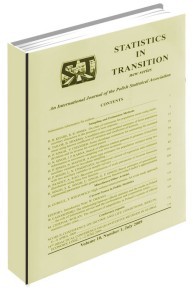Taxonomic Analysis of the Polish Public Health in Comparison with Selected European Countries
Taxonomic Analysis of the Polish Public Health in Comparison with Selected European Countries
Author(s): Anna WierzbickaSubject(s): Economy
Published by: Główny Urząd Statystyczny
Keywords: Public health;taxonomic measure of development;comparative analysis
Summary/Abstract: As an international organization the European Union pursues a range of purposes including improvement of public health, prevention of human illness and diseases as well as elimination of the sources of danger to physical and mental health. To enable effective health policies supporting actions of the member states, the data and materials which are fundamental to public health assessments are collected at the Community level. They underpin a variety of analyses necessary to evaluate changes in medical systems and determine the degree of similarity between the EU member states.This article analyses public health in Poland in relation to selected European countries. The study is based on the medical, economic and social indicators available from the EUROSTAT database. The taxonomic methods used in the study allowed ranking the sampled countries and identifying those with the highest level of public health. A more detailed assessment was based on the general presentation of health care systems in each country. In addition to Poland, the other post-socialist countries in the sample are Bulgaria, Estonia, Lithuania, Romania, Slovenia, Hungary and the Czech Republic. Importantly, the study covers the years 2004-2009, after most of the countries joined the European Union. The reason why other former Eastern bloc countries were omitted from the study was the unavailability of appropriate data in the EUROSTAT database. The paper discusses a group of developed European countries too. However, because the complicated historical past of the post-socialist countries and the socio-economic difficulties that result from it make their analysis more interesting from a comparative point of view, they are the primary group explored in this article.This article is divided into theoretical and empirical section. It begins with a short introduction. Part two presents the concept of health and public health. The third part describes key factors differentiating health systems. It briefly presents the main healthcare models, that is: the Bismarck’s, Beveridge’s, Siemaszko’s and the residual model. The fourth section refers to a grouping method based on Hellwig’s taxonomic measure of development. Part five with its scope includes acomparative analysis of public health status of selected European countries. The sixth part presents major determinants of cluster formation. The paper ends with a conclusion that summarizes the obtained results.
Journal: Statistics in Transition. New Series
- Issue Year: 13/2012
- Issue No: 2
- Page Range: 343-364
- Page Count: 22
- Language: English

